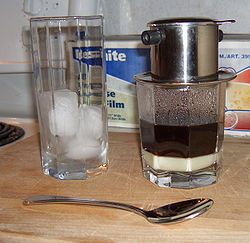|
Vietnamese iced coffee
Vietnamese iced coffee (Vietnamese: cà phê đá, lit. 'iced coffee') is a traditional Vietnamese coffee recipe. It is created using coffee roasted between medium and dark. The drink is made by passing hot water through the grounds into a cup that already contains condensed milk. To serve the drink cold, ice is added to the cup. Variations Variations involve additions of ice, sugar or condensed milk. A popular variation is cà phê sữa đá (or nâu đá in the North), which is iced coffee served with sweetened condensed milk.[1] This is done by putting two to three teaspoons or more of condensed milk into the cup prior to the drip filter process. Other variations include:
HistoryCoffee was introduced to Vietnam in 1857 by a French Catholic priest in the form of a single Coffea arabica tree.[4] The beverage was adopted with regional variations. Because of limitations on the availability of fresh milk, as the dairy farming industry was still in its infancy,[5] the French and Vietnamese began to use sweetened condensed milk with a dark roast coffee. Vietnam did not become a major exporter of coffee until the Đổi Mới reforms and opening of the economy after the war. Now, many coffee farms exist across the central highlands. Vietnam is now the largest producer of the Robusta variety of coffee and the second largest producer of coffee worldwide.[6] See also
References
External linksWikimedia Commons has media related to Ca phe sua da.
|
||||||||||||||||||
